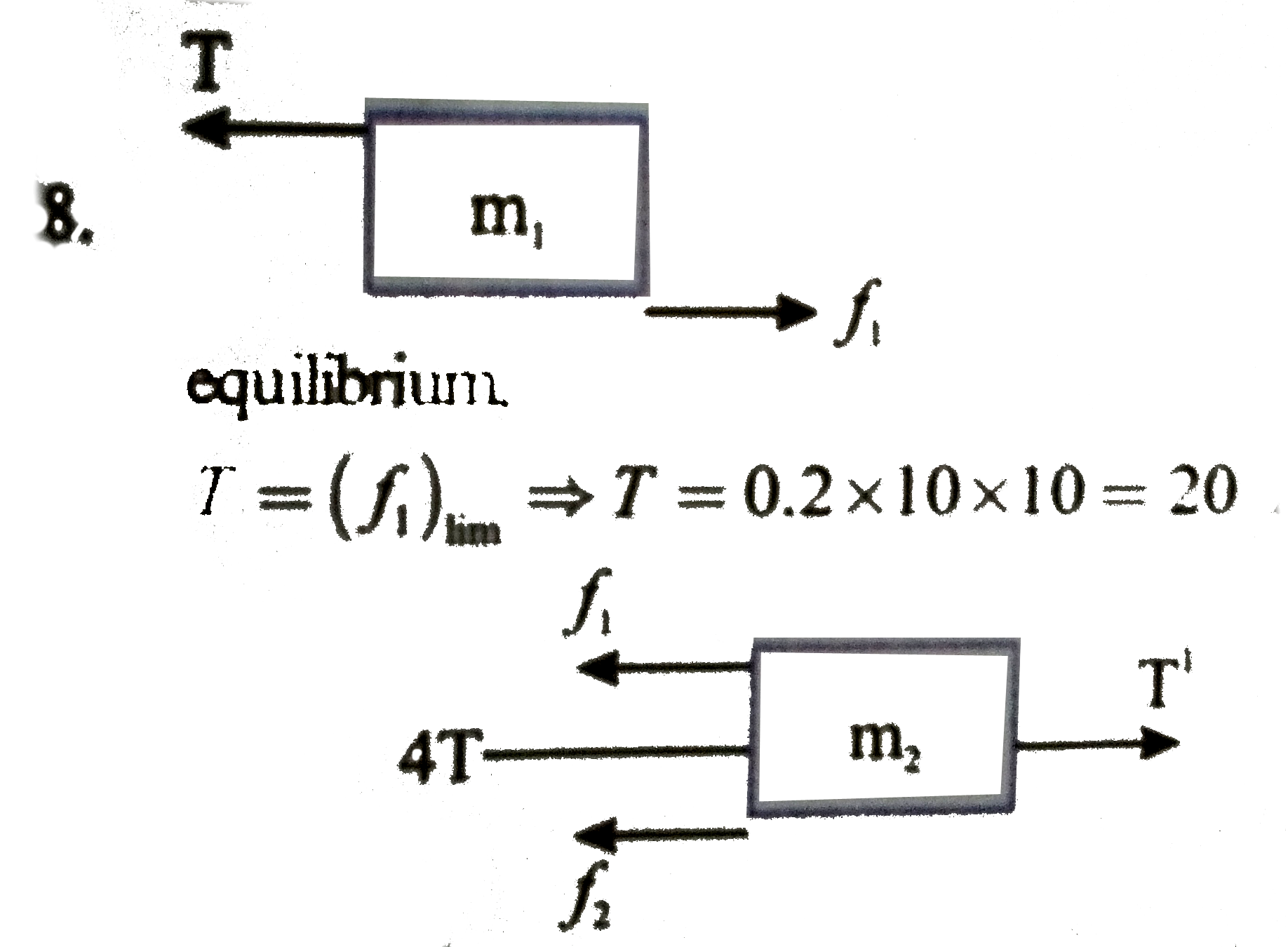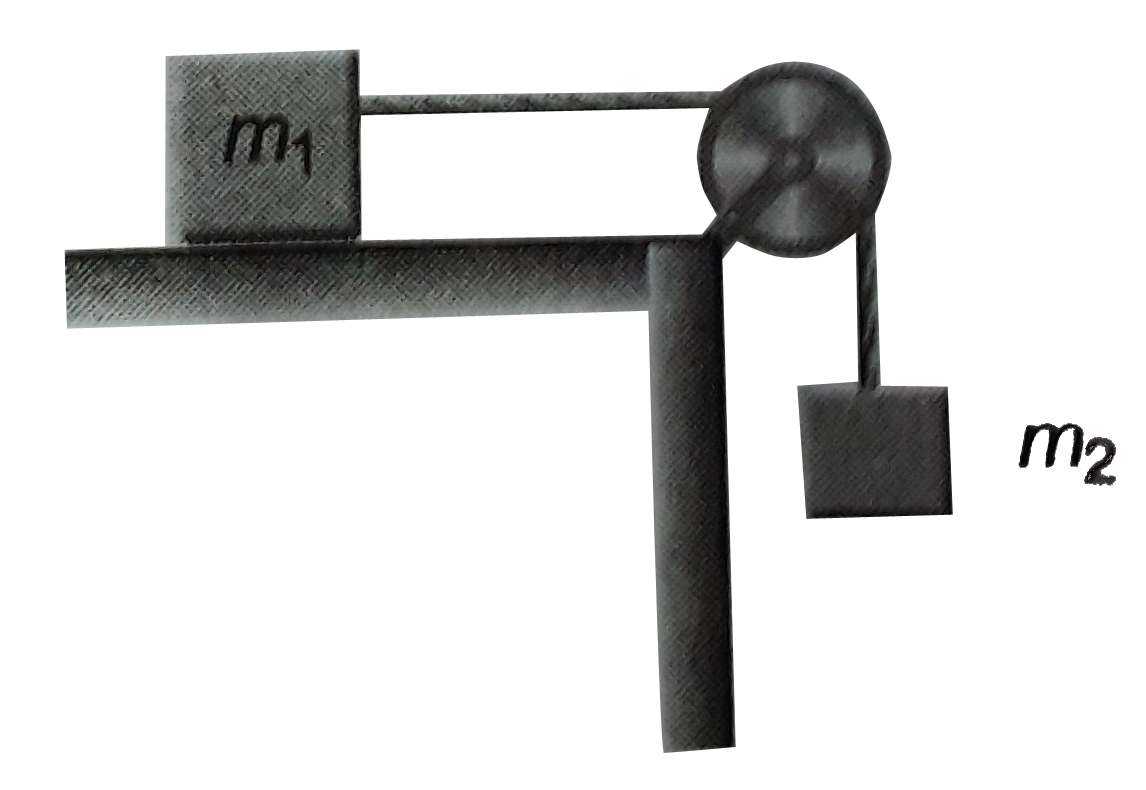In the figure, m1=m2=10kg. The coefficients of friction between A,B and B, surface are 0.2. Find the maximum value of m3 so that no block slips ( All the pullies are ideal and strings are massless).

16kg
10kg
18kg
14kg
The correct Answer is:D

(f2)lim=⋅(m1+m2)g=0.2×20×10=40N
T1=m3g and T1=f1+f2+4T
⇒m3(10)=20+40+4(20)⇒m3=14kg
Topper's Solved these Questions
- FRICTIONBook:NARAYNAChapter:FRICTIONExercise:Multiple answer question
Explore 20 Videos
- FRICTIONBook:NARAYNAChapter:FRICTIONExercise:Passage type of questions
Explore 6 Videos
- COLLISIONBook:NARAYNAChapter:COLLISIONExercise:Level-II (H.W)
Explore 54 Videos
- GRAVITATIONBook:NARAYNAChapter:GRAVITATIONExercise:EXERCISE -IV
Explore 40 Videos
Similar Questions
The block A in the given figure is of mass 10√3 kg The coefficient of friction between the block and the surface on which it rests is 0.5. Find maximum mass of block B possible such that the system will be in equilibrium is.

View SolutionThree blocks A, B and C, whose masses are 9kg, 9kg and 18kg respectively as shown in the figure, are released from rest. The co-efficient of friction between block A and the horizontal surface is 0.5 & the co-efficient of friction between block B and the horizontal surface is 0.5. Find the acceleration of block C just release [Take g=10m/s2]. All strings and pulleys are ideal

View Solution
Knowledge Check
1kg and 4kg blocks lie on a rough horizontal surface. The coefficient of friction between 4kg blocks and surface is 0.2 while the coefficient of firction between 1kg blocks and the surface is 0.6. All the pulley shown in the figure are massless and frictionless and all strings are massless and frictionless and all strings are massless.
 AThe frictional force acting on 1kg blocks is 2N.BThe frictional force acting on 1kg block is 6NCThe tension in the string connecting 4kg block and 1kg blocks is 1NDThe tension in the string connecting 1kg block and 4kg blocks is zero.
AThe frictional force acting on 1kg blocks is 2N.BThe frictional force acting on 1kg block is 6NCThe tension in the string connecting 4kg block and 1kg blocks is 1NDThe tension in the string connecting 1kg block and 4kg blocks is zero.In the figure mA=mB=mC=60kg. The coefficient of friction between C and ground is 0.5B and ground is 0.3,A and B is 0.4.C is pulling the string with the maximum possible force without moving. Then the tension in the string connected to A will be
 A120NB60NC100NDzero
A120NB60NC100NDzeroIn the figure shown m1=5kg,m2=10kg & friction coefficient between m1&m2 is μ=0.1 and ground is frictionless then :
 AIf a horizontal force F=20N is applied on m1 then the friction force acting on m2 is 5 N in the direction of FBMaximum amount of horizontal force that can be applied to m2 such that there is no relative motion between blocks is 15 NCIf a horizontal force F=20N is applied on m2 then friction force acting on m1 is 20/3 N in the direction of applied forceDMaximum amount of horizontal force that can be applied to m1 such that there is no relative motion between blocks is 8 N
AIf a horizontal force F=20N is applied on m1 then the friction force acting on m2 is 5 N in the direction of FBMaximum amount of horizontal force that can be applied to m2 such that there is no relative motion between blocks is 15 NCIf a horizontal force F=20N is applied on m2 then friction force acting on m1 is 20/3 N in the direction of applied forceDMaximum amount of horizontal force that can be applied to m1 such that there is no relative motion between blocks is 8 N
Two blocks A and B of masses mA=1kgandmB=3kg are kept on the table as shown in figure. The coefficient of friction between A and B is 0.2 and between B and the surface of the table is also 0.2. The maximum force F that can be applied on B horizontally, so that the block A does not slide over the block B is ________ (in N): [Take g=10m/s2]

View SolutionConsider three blocks placed one over the other as shown in Fig. Let as now pull the blocks with the force of magnitudes 18N,100N and 15N Take m1=m2=m3=10kg If the coefficient of static and kinetic friction between all contacting surface are μg=0.2 respectively find the

(a) Acceleration of the block s
(b) Friction at each surface
View SolutionTwo masses m1=10Kg and m2=5kg are connected by an ideal string as shown in the figure. The coefficient of friction between m1 and the surface is μ=0.2 Assuming that the system is released from rest calculate the velocity of blocks when m2hasdescendedby4m.(g=10 m//s^(2))
 .
.
View SolutionA block of mass m1 connected with another of mass m2 by a light spring of natural length l0 and stiiffness k is kept stationary on a rough horizontal surface . The coefficient of friction between m1 and surface is μ and the block m2 is smooth .The block m2 is moved with certain the block m1 in horizontal plane Find the (a) maximum to m1 and (b) acceleration of m2 in part(a)

View SolutionThere block A B ,and C of equal mass m are placed one over the other on a frictionless surface (table) as shown in figure The coefficient of friction between any blocks A ,B and C is μ The maximum value of mass of block D so that the blocks A,B and C move without slipping over each other is

View Solution

